The Simple Key To Weight Loss Everyone Forgets About
Are you tired of struggling with your weight and figuring out what to eat?
Then it’s time you should look into balancing your meals and your blood sugar levels. You will gain more energy, a healthier body, and bonus, you will lose weight and actually keep it off! We all want that don’t we? No fancy diet plan, no expensive program… just maintaining a healthy balance of what you eat with fresh whole foods. So let’s dive right in and make a change in your body.
First, what is your blood sugar level and why is it important for health and weight loss
Blood sugar (glucose) is produced when you break down any carbohydrate (the good and the bad). It either provides your body with immediate energy or the glucose is stored for future use, both via the hormone insulin. Your blood sugar level reflects the amount of glucose that is moving around in your bloodstream. It determines how energetic and how hungry you may feel.
If your blood sugar levels are in proper balance… your overall health will be improved and your hormones will be more regulated. Long story short…when your hormones are regulated, your body starts to burn stored fat and increases your metabolism… which will help you lose weight. 🙌
Reality…
Most people’s blood sugar levels are not properly balanced.
- If you’re getting too much glucose (blood sugar levels are high): Your body can’t break it all down and ends up storing it as FAT. dun dun dun! 😩
- If you’re not getting enough sugar (low blood sugar levels): This can also lead to putting on extra pounds! 🤯 It can cause your body to go into “starvation mode” where it burns your lean muscle instead of the fat. Bummer right!
A double blow to your system and your diet!
The plan
When you eat the right amount and right kinds of protein, fat, carbohydrates and fiber at each meal, you will prevent any significant insulin spikes and dips. Plus, you will be helping your body naturally stabilize its blood sugar to burn fat and have consistent energy throughout the day! This helps facilitate long-term healthy fat loss. Your metabolism will also stay high so that you process food quicker.
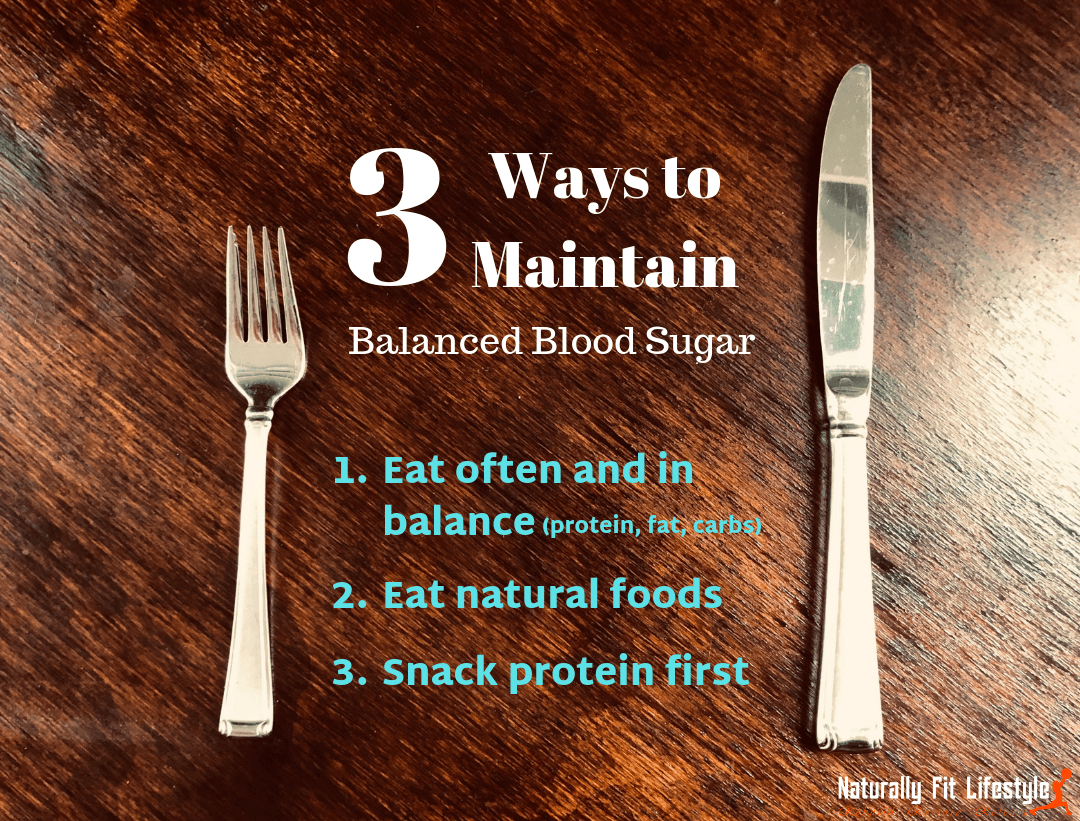
Here are 6 simple steps to remember, in order to get your body on the right track for health and weight loss
STEP 1: Eat in 3s
Eat every 3 hours and divide your plate into 3 food main groups: protein, good fats and good carbohydrates.
Eating every 3 hours
Our bodies were designed to take care of themselves. So if there are large gaps between the times you eat… your body will naturally go into starvation mode. It’ll start to store the foods you consumed last to “survive off of”. Many doctors claim 3 hours is a good gap between each meal and snack to prevent your body from storing fat.
TIPS:
- Be sure to eat within 1 hour of waking up. This “wakes up” or “speeds up” the metabolism again. As you fast during the night, your body focuses on healing and repairing- not digesting. This is why your metabolism slows down while you sleep.
- Then eat every 3 hours thereafter. For example: Wake up: 5:45am, Breakfast: 6am, Snack: 9am, Lunch: 12pm, Snack: 3pm, Dinner: 6pm. Small light snack if need around: 8ispm Bed: 10ishpm (adjust for workouts or earlier or later wake up and bedtimes).
- Stop eating at least 2-3 hours before you go to bed. This will help you fall asleep faster and help your body get more rest and time to heal and recover.
Please don’t starve yourself…
…thinking that is better than skipping a meal or snack! Not only does starvation generate the production of stress hormones like cortisol that prevents weight loss, but the outcome is also low blood sugar. As I mentioned earlier, low blood sugar causes the body to burn muscle, instead of fat. This can ultimately lower the metabolism as well.
Dividing your plate into 3 food main groups
The easiest way to stabilize blood sugar within the normal range is to eat a balance of protein, good fats, and good carbohydrates at each meal and snack.
It depends on your body composition goals, but the general consensus for percentages to aim for are:
1. Protein: 10-35% of calories or a palm-size serving.
2. Good Fat: 20-35% of calories or a full thumb-size serving.
3. Good Carbohydrates: 45-65% of calories or a fist-size serving… unless they consist of all veggies- then it’s unlimited.
Below is a brief guide for some ideas of foods under each category. You can pick one food from each category, in the right portion size, to obtain balance within your meal or snack.
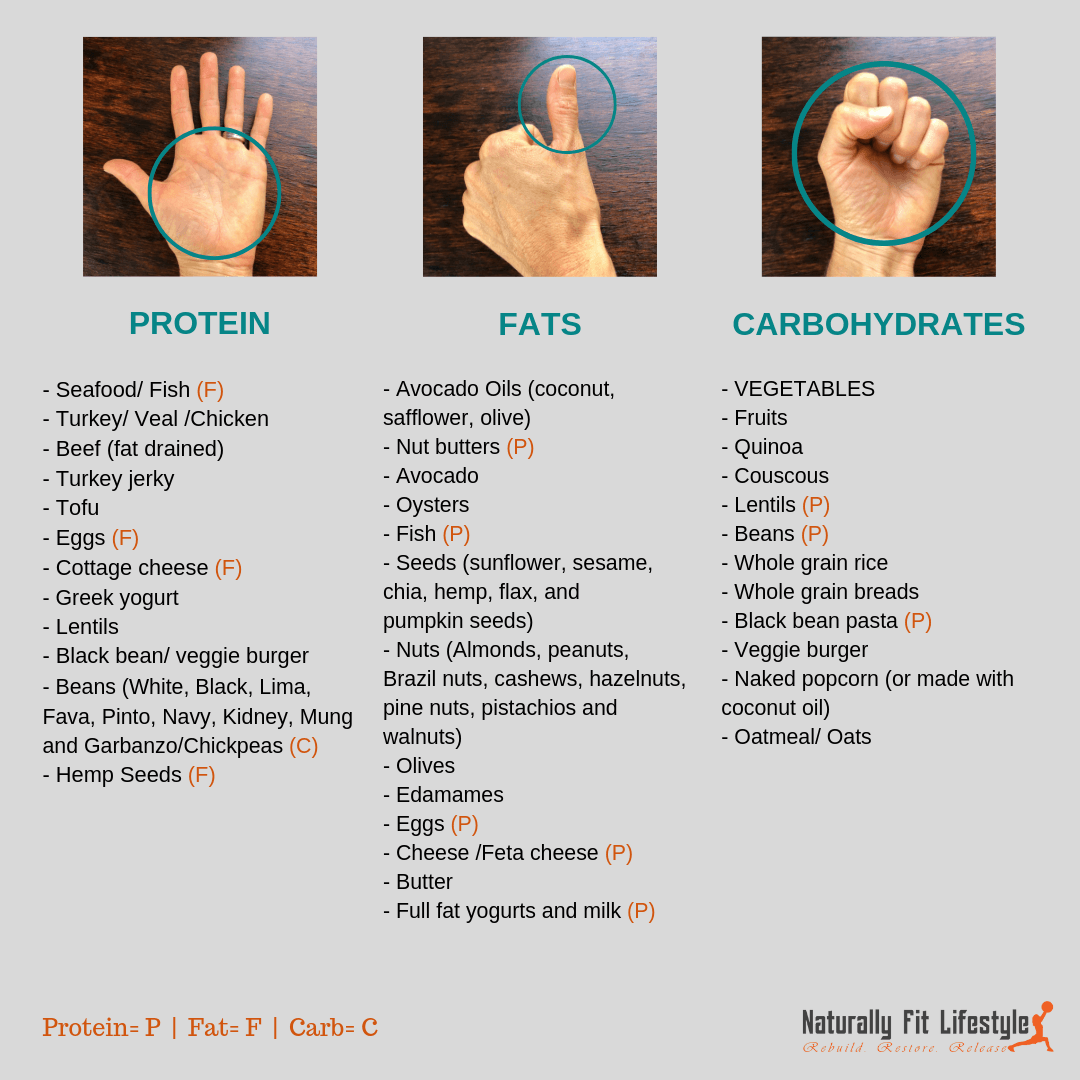
So let’s change the way you think…
Many people don’t think about balance when they grab something to eat. For example, you grab a banana for a snack, as you run out the door. Well, a banana is a great source of nutrients but is a carbohydrate alone and will spike your blood sugar levels. So it needs to have a protein and fat added to it, like no sugar added peanut butter. When combined with the peanut butter, it will help slow down digestion and provide you with more lasting energy.
So just make sure you think about having a balance of protein, good fats and good carbs when grabbing a snack or putting together a meal, to avoid spiking your blood sugar.

STEP 2: Plan Your Meals and Prepare Snack Kits
This way you are preparing yourself to be successful to eat balanced, (protein, fat and good carbs), every 3 hours – no matter where you are.
Meals:
I plan my meals on the weekend (usually Sunday night). I make a list for meals we will eat, each day of the week and another list for all the groceries I need, to make those meals. Then on Monday morning, I go shopping with my boys. I have the luxury of preparing my dinner meals in the afternoon (at nap time) so they are ready to be eaten by 5:15pm. But, if you work full time and cannot do that, find another time that works for you. Preparing part of a meal beforehand (like cutting veggies, cooking the meat, etc), can help your “before dinner” prep, go a lot smoother. Plus it will help you and everyone else avoid snacking right before the nutritious meal.
Snacks:
You’ll also want a “grab and go” kit with two or three 250-400 calorie snack meals to eat between breakfast and lunch AND between lunch and dinner. I usually plan these for myself and my kids the night before or earlier in the morning before everyone gets up. I’ve learned with kids, I can’t get them together when they are around because they just want to eat all the snacks. 😆
Here are 3 sample balanced snack ideas to get you started:
- Snack 1: Turkey jerky for protein, a small handful of nuts for good fat, and an apple for the good carbs
- Snack 2: A natural protein bar with equal-ish parts protein, fat and carbs. Avoid bars that have over 5-7 grams of sugar, along with a lot of dairy and artificial ingredients. Pea protein is big right now and makes more natural bars made with real fruits, seeds and grains, balanced.
- Snack 3: 1 hard-boiled egg (protein and good fat), a few cherry tomatoes and slices of cucumbers for the good carbs
Here are 2 sample balanced meal ideas:
- Breakfast: Eggs (fat and protein if eating the whole egg- which is good for you despite what people tell you) and a red pepper for good carbs
- Breakfast: Smoothie (chia, hemp, flax seeds (good fats), bone broth protein powder (protein), fruits and veggies (carbs))
- Lunch: Baked Fish cooked with a little coconut oil, ½ a sweet potato
- Lunch: Egg salad (Hard-boil eggs, sliced/mashed avocado) served over quinoa
- Dinner: Chicken or black beans with avocado on a bed of mixed greens with a little oil
- Dinner: Black bean spaghetti, homemade sauce, with olives on top
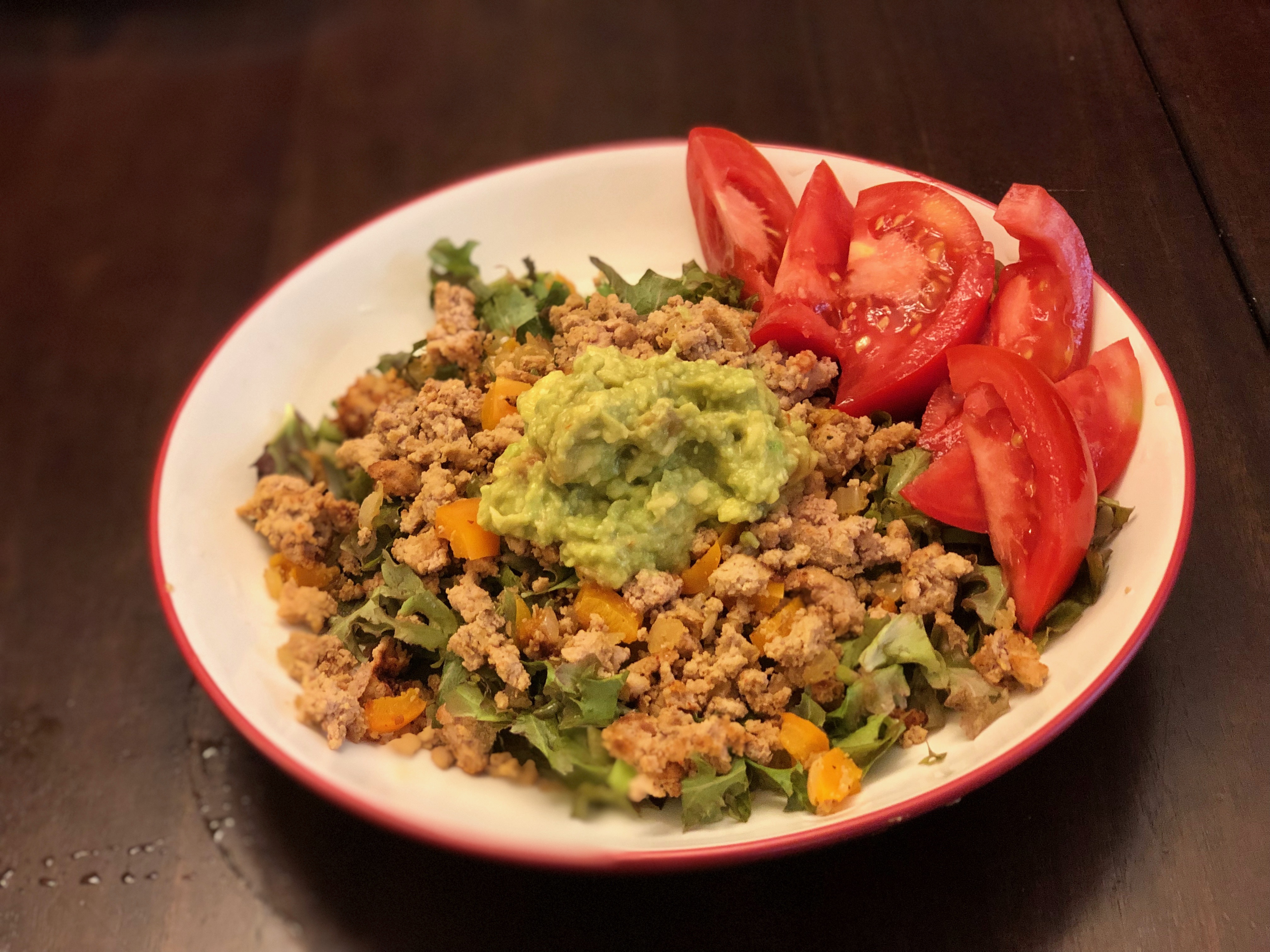
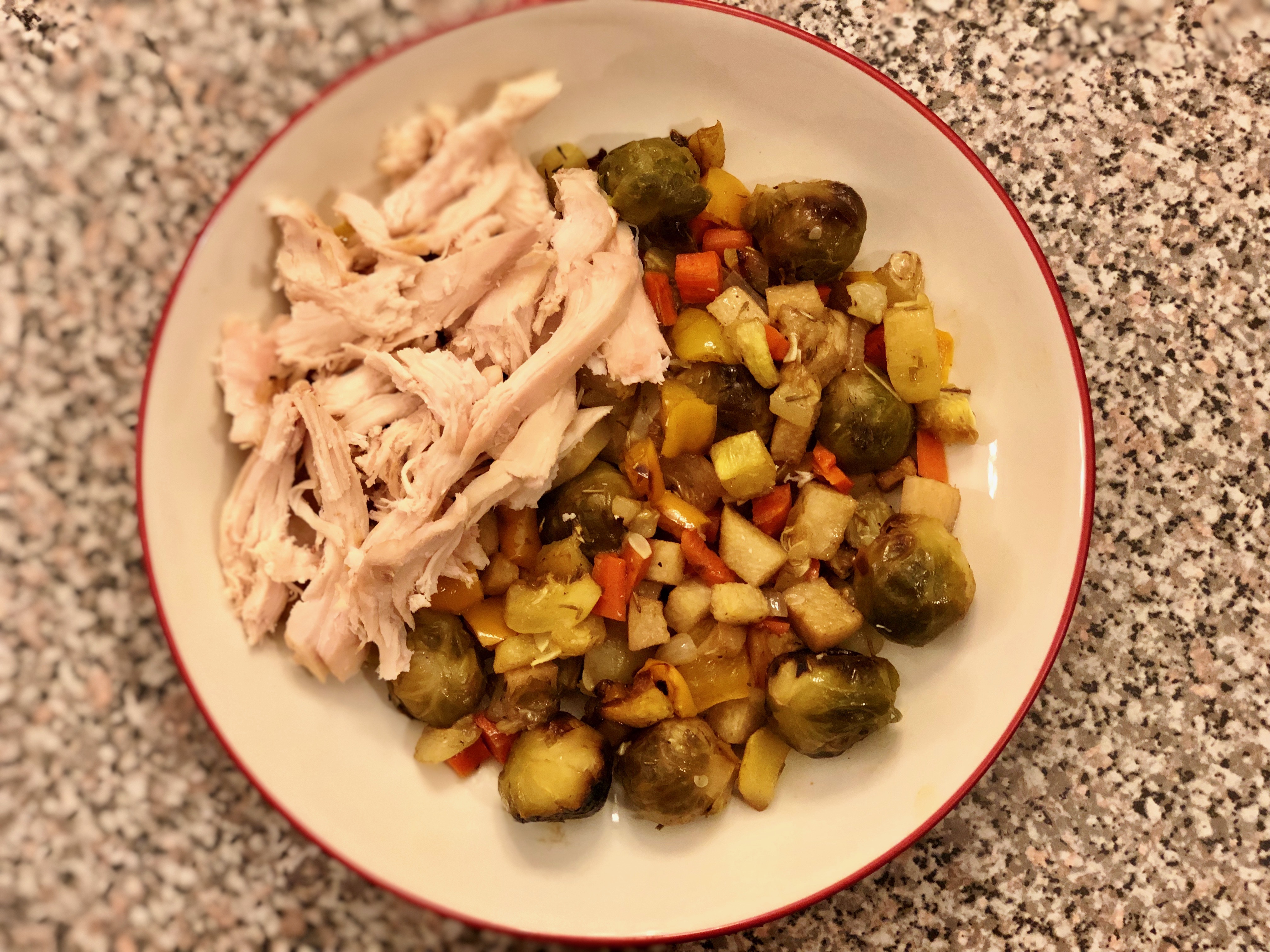
Bonus: As your blood sugar stabilizes by sticking to the 3s rule, you will begin to release previously stored fat. Then the leaner you get and the more muscle you build, the more you’ll be able to eat. That’s the power of having lean muscle and eating in 3s!
STEP 3: Eat More of Your Food at the Begining of Your Day
Breakfast should be your largest meal of the day, then Lunch and then Dinner. I know it is so hard in today’s fast-paced world … but it just takes some planning. I even struggle with it. One way we manage to eat a larger lunch then dinner is that we eat a smaller portion at dinner time. Typically we eat leftovers for lunch. So we just make sure we still have a balance of protein, fats and good carbs in our meal, but add a little extra protein for lunch (because we are pretty active). Then we tend to eat balanced… but more vegetable-heavy for dinner.
With a lighter balanced dinner, you’re ready the next morning to eat a nice nutrient-packed balanced breakfast to get you going for the day!
DON’T SKIP BREAKFAST! IT’S TOO IMPORTANT!
Breakfast is the most important meal of the day! Break-fast literally means you are “breaking” your “fast” from the night. Your metabolism does not speed up again until you put something in your mouth in the morning. Even if its just 1 almond or grape… that will start up your metabolism. Then later you can eat more as long as it’s within the first hour after you wake up- so you maintain a more leveled blood sugar.
Below is a great chart that describes what happens to your body if you skip breakfast, if you eat a carbs-based breakfast or if you eat a balanced protein-based breakfast. We all want to strive for a balanced protein-based breakfast for optimal health, our sanity, increased energy and even weight loss!
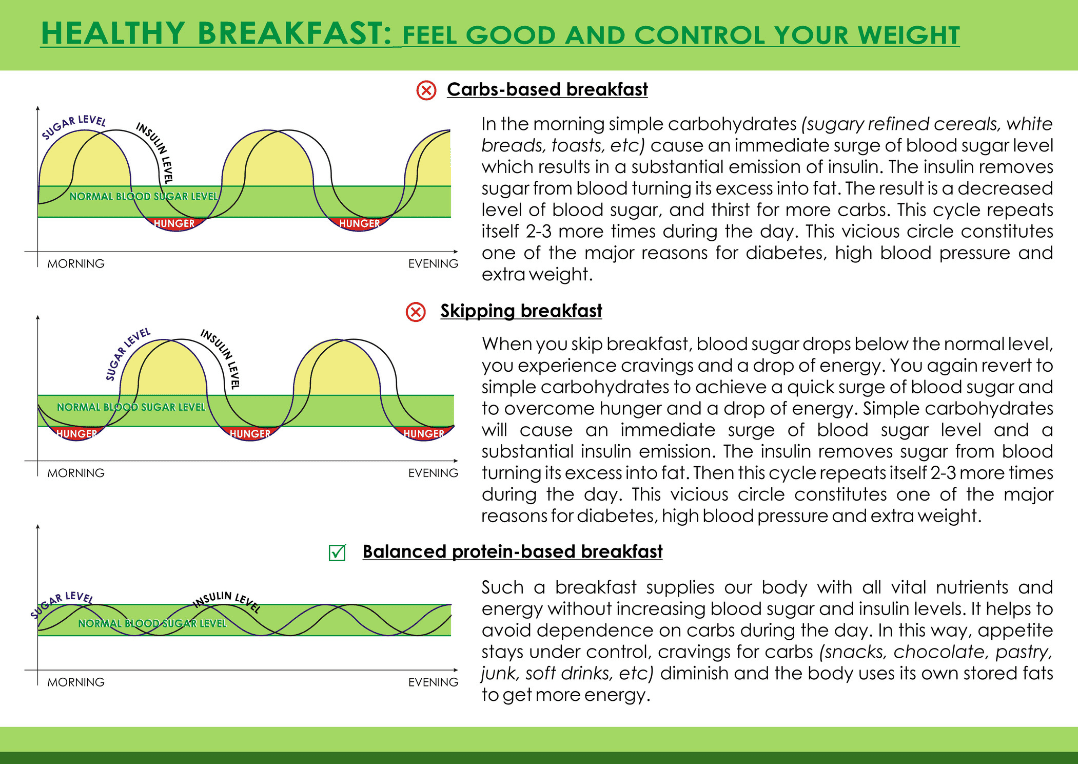
STEP 4: Eat 3 Ounces of Protein Before Every “Cheat”
I don’t even like to use the word “cheat” because I like to consider eating to be apart of your healthy lifestyle… not a “diet”. Where you can fall off the wagon here and there and have good days and bad days. You’ve just got to have balance in your life and do things in moderation. So the right way to have balance… is to enjoy those simple pleasures like brownies and pasta, but in moderation throughout the week and with some protein.
So first moderation:
You’re not going to binge eat brownies if you allow yourself to have it every so often. I promise! Sure at first, you have to fight the craving… but with time, you will be able to just eat a small serving, in one sitting and leave it alone for the rest of the day. And if you cannot do that… if the self-control is not there yet… then just keep it out of your house for now, until you feel like you can have control.
Now add the protein:
Weird right! Well when you do decide to have that brownie or that glass of wine during nap time, then first, eat 3 ounces of protein! – 3 ounces of turkey breast, cottage cheese, greek yogurt. Protein is your friend when indulging in heavy carbs because it helps slow digestion and decreases your blood sugar from spiking. 🙌
STEP 5: Choose Complex Carbs Over Simple Carbohydrates
Simple carbohydrates consist of sugars that can be found naturally in foods (fruits and dairy) or in not very natural sources. These can include, processed and refined foods (hidden in beverages, sweets, breads, chips, fat-free foods…). Simple carbohydrates are quickly digested and absorbed by the body. So they provide your body with quick, immediate energy. Energy that is there… and then gone just as fast!
INSTEAD:
Eat meals and snacks rich in good fats, protein and complex carbs. Complex Carbohydrates, the good carbs, can be found in vegetables and legumes. These are needed nutrients, as they provide vitamins, minerals, and fiber that are important for your health. Complex carbs take longer to digest and are a more lasting source of energy.
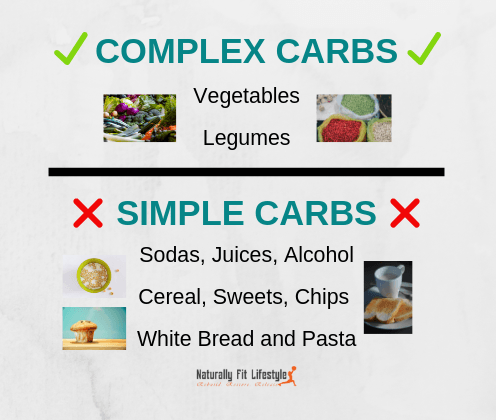
STEP 6: Exercise
Exercise! Many studies over the years have shown that there are so many proven benefits of exercises. It changes your body’s composition, improves your resting metabolism and alters your food preferences. You’ve probably noticed that when you begin exercising more regularly- you tend to make healthier food choices and find yourself wanting to plan your meals and snacks and to also eat in balance. These 3 plain and simple facts have stood the test of time… despite all the new fads and trends out there.
A few fun facts:
- Exercise that makes your heart beat a little faster and your breath increase, causes your muscles to use more glucose (the sugar in your bloodstream). Over time this will help lower your blood sugar levels and help make the insulin in your body work better.
- Our skeletal muscles are made up of two different types of fibers: Slow-twitch muscle fibers (red) and fast-twitch muscle fibers (white). You activate your white, fast-twitch muscle when you do something explosive, like running upstairs or powerlifting. You activate your red, slow-twitch muscles with steady exercise like walking around the park or doing light weight training.
-
- If you only work out one, it’s like you’re only burning fat in 50% of your body, so it’s vital to work out both. That’s why it is so important to mix up your workouts. Do a good mix of cardio and strength in each workout. Plus, when you build muscles… those muscles burn even more calories later on in the day, as they are repairing- all while you’re sitting there resting. So it’s kind of like your still working out. 🤗
-
To Review
YOUR 6 steps to get your body on the right track for health and weight loss:
Step 1: Eat in 3s (every 3 hours and have a balance of THE 3: protein, good fat and good carbs)
Step 2: Plan your meals and prepare snack kits
Step 3: Eat more of your food at the beginning of the day
Step 4: Eat 3 ounces of protein before every “cheat”
Step 5: Choose complex carbs over simple carbohydrates
Step 6: Exercise!
Have fun obtaining balance within your body, with your choices, and on your plate! 🥰
If you want more information how to lose weight or make a nutritional lifestyle change, check out my “A Life of Balance: Interactive Nutrition Guide and Easy Cookbook” here.



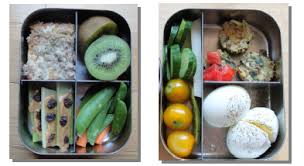
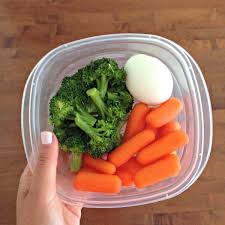







Great job it’s sounds so simple and has plenty of examples and ideas for replacing the bad with the good!
Thank you!
Awesome article, brought together a lot of information I’ve seen separately into one place! Super helpful!
Great! Thank you so much for the feedback and sharing with me! I’m glad it was helpful for you 🧡